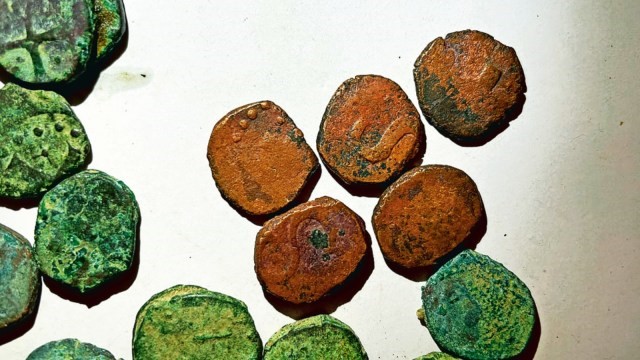Description

Disclaimer: Copyright infringement not intended.
Context
In North Goa's Nanoda Bamber village, a discovery of 832 copper coins in a buried pot has surfaced. These coins are believed to have been minted in Goa during the 16th or 17th Century, a period when the region was under Portuguese rule.
Details
Introduction to Portuguese Colonial Coins
Historical Context
- Colonial Expansion: Portuguese exploration and colonization efforts in the 15th to 19th centuries spanned regions like Africa, Asia, South America, and the Indian Ocean.
- Cultural Exchange: The circulation of coins reflected not just economic transactions but also cultural interactions between Portugal and its colonies.
Types of Coins
- Variety: Coins issued during the Portuguese colonial era varied in metals, denominations, shapes, and designs, reflecting the regions' local traditions and resources.
- Local Influence: Some coins adopted indigenous symbols or cultural elements, showcasing a blend of Portuguese and local aesthetics.
Coins from Different Regions
Brazil
- Gold Coins: Brazil produced gold coins known as "Johannes" or "Peças de Ouro," reflecting the wealth from Brazilian mines.
- Copper Coinage: Copper coins known as "Patacas" were also minted for local circulation.
India
- Portuguese Indian Coinage: Coins minted in the Indian subcontinent showcased the blend of Portuguese and Indian artistic motifs, denominations, and metals.
- Rupia and Xerafim: Rupia and Xerafim were notable denominations used during the Portuguese rule in Goa, Daman, and Diu.
Africa (Angola, Mozambique, Guinea, etc.)
- Copper and Bronze Coins: Some regions minted copper and bronze coins, often featuring local symbols or rulers' names alongside Portuguese insignia.
- Trade Coins: Coins were also minted to facilitate trade, especially in regions engaged in the slave trade.
Significance
- Historical Significance: Portuguese colonial coins serve as valuable artifacts, providing insights into economic systems, cultural exchanges, and historical events during that period.
- Collectors' Interest: Numismatists and collectors highly value these coins for their rarity, historical context, and intricate designs.
- Cultural Reflection: Coins from the Portuguese era stand as a testament to the mingling of Portuguese and indigenous cultures, showcasing the diverse heritage of the colonial territories.
- Heritage Preservation: Efforts to preserve and study these coins contribute to the understanding and preservation of cultural heritage.
Portuguese Coins in Goa
- Gold, Copper, and Silver: Portuguese coins in Goa were minted in gold, copper, and silver, representing various denominations.
- Gold Coins: Examples included 'Cruzado,' 'Manoel,' 'Meio-manoel,' while silver coins included 'Espera' and 'Meia-espera.'
- Features on Coins: The gold 'Manoel' and silver 'Espera' coins typically showcased the Cross of the Order of Christ on the obverse side and the armillary sphere, symbolizing King D. Manoel, on the reverse.
- Half-Piece Details: Half pieces of these coins had 'MEA' surmounted by a crown on one side and the armillary sphere on the other.
Religious and Cultural Depictions
- Patron Saint: The Portuguese adopted Apostle St. Thomas as their patron saint for India, leading to the effigy of St. Thomas being etched on Indian coins. These coins were named 'St. Thome.'
- Thomas Representation: The gold and silver coins depicted a seated or standing figure of St. Thomas, with initials 'S' and 'T' on one side and the crowned arm of Portugal with the monarch's initials on the other.
Value and Mintage Locations
- Value: The gold coins had denominations of 20, 10, 5, and 2 'Xerafirms,' reflecting various values.
- Mintage Locations: Mints were established at Bassein and Daman in 1611 to issue copper 'Buzaruccos' and later 'tutenag' coins. The 'Buzaruccos' depicted the coat-of-arms on one side and a sheaf of arrows on the flip side.
Historical Significance and Context
Timeline of Issue and Suspension
- Suspension and Reintroduction: The issue of these coins was suspended by the Governor of Goa in 1519, only to be reintroduced in 1549.
- Adoption of St. Thomas: The coins reflected the adoption of St. Thomas as a patron saint and were redesigned to include his effigy and related symbols.
.jpg)
Conclusion
Coins from the Portuguese colonial period represent a blend of historical, cultural, and economic influences. They serve as tangible artifacts of the colonial past, offering insights into the interactions between Portugal and its colonies, shaping the numismatic landscape and preserving a significant part of global history and cultural heritage
|
PRACTICE QUESTION
Q. During the Portuguese colonial era, which of the following features were characteristic of the coins minted in Goa?
- The coins featured the Cross of the Order of Christ on the obverse side and the armillary sphere, symbolizing King D. Manoel, on the reverse.
- The copper 'Buzaruccos' depicted the coat-of-arms on one side and a sheaf of arrows on the flip side.
- St. Thomas was depicted on both sides of the coins, with initials 'S' and 'T' on one side and the crowned arm of Portugal with the monarch's initials on the other.
- The gold coins were issued in denominations of 'Pagodas' or 'Hons' which were similar in size, value, and weight to the 'Cruzado' or 'Manoel' coins.
Options:
A. 1 and 2
B. 2 and 3
C. 1 and 4
D. 3 and 4
Answer: A
|
















